Home prices pulled back in January, despite increasingly tight
inventory and robust sales. Supply and demand will be
discussed later; first, some graphs on prices.
The median price per square foot fell on a month-to-month basis by
.9% for detached homes, 6.4% for condos, and 2.3% in
aggregate. The graph below shows that such huge moves occur
somewhat routinely for condos, so as always, it makes more sense to
pay attention to the detached home line in blue.
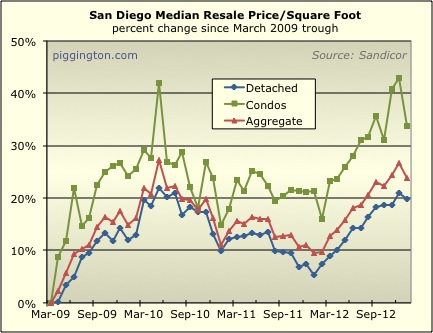
Here’s a look at prices starting from the bubble peak:
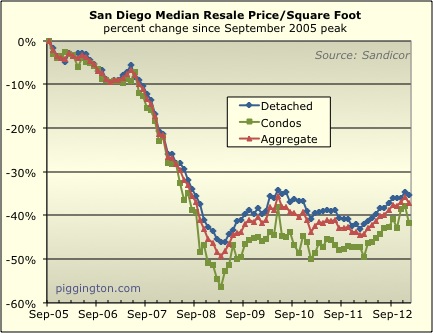
The Case-Shiller proxy (which uses a 3-month moving average of the
single family price per square foot) was up .3% for the month.
Here’s a chart from the trough, showing that the uptrend that began
a year ago thus far remains intact despite last month’s weakening of
the price per square foot:
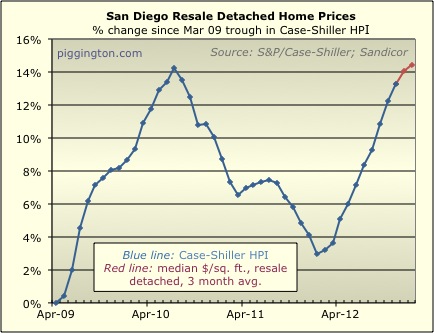
Same thing from the bubble peak:
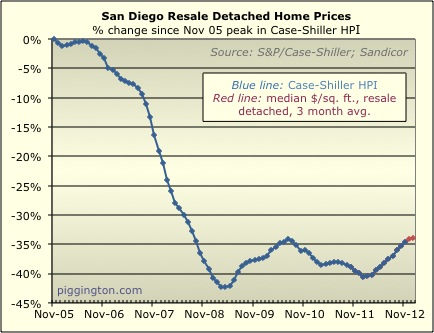
Meanwhile on the supply front, inventory has continued to plummet:

Here’s another look at inventory, but separated out by year so you
can compare months with like months. Look at that lonely
little blue square down there on the left… this is totally unlike
what we saw a year ago (down 40%, to be specific).
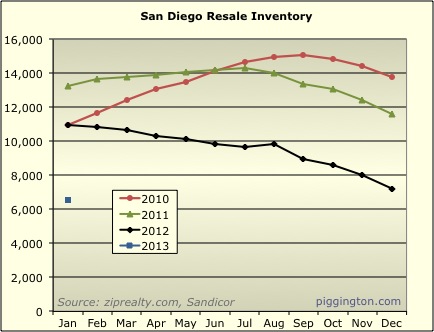
The difference in active inventory (which excludes contingents,
i.e., short sales with offers waiting for bank approval) is even
more stark — down 50% from a year ago!
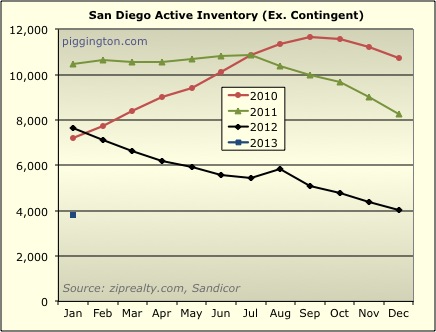
Meanwhile sales activity was fairly robust, with January actives and
pendings higher than in recent years:


And thus did months of inventory continue its plunge into the abyss:
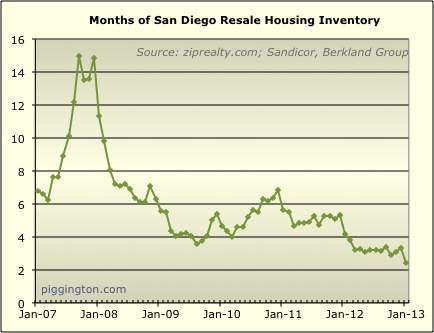
Again, behold the lonely blue square — this one 43% below its level
of a year ago:

Months of inventory is very important in my view, because it seems
to drive near-term price movements per this chart that I am always
going on and on about:
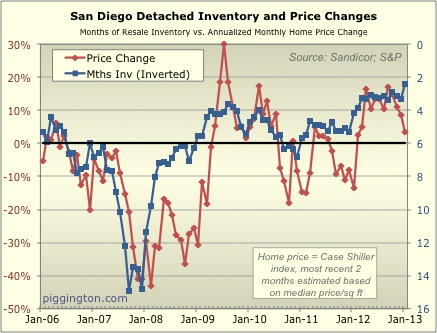
Well, now we’ve hit a new post-bubble low in months of
inventory. Interesting that prices actually weakened the same
month, but I am not making too much of this, because the seasonal
tendency is for prices to be weakening now.
In the past, divergences between these two series have resolved
themselves in favor of months-of-inventory. If that continues
to be the case, and inventory remains this constrained, then we
should expect further price gains to come.

Good to see PPSF easing up a
Good to see PPSF easing up a bit, but the volatility in the condo price is unreal.
I think the condo volatility
I think the condo volatility is largely an artifact, which is why I don’t pay too much attention to that series.
There is a much smaller sample size for condos (597 sales last month vs. 1854 for detached), and also a bit more variance in prices (first standard deviation is 64% of the median price, vs. 57% for detached).
So it’s mostly noise I think…
I think the volatility is
I think the volatility is also a symptom of the low inventory. There are less data points used find the median and thus greater error in the results.
What do you think might be
What do you think might be causing the low inventory? It doesn’t look like sales volume is too far off from prior years. Maybe a drop in new construction? Are people just not interested in selling their homes for some reason?
This is big contrast from a couple years ago when “shadow inventory” and the effects of builders overbuilding during the bubble were thought thought to be a drag on home prices for years to come.
Why sell if they can sit in
Why sell if they can sit in them without making payments and wait for (maybe) prices to go up enough for them to get above water? New laws have made it very hard to foreclose in CA, so there’s less incentive to sell short.
Ed wrote:What do you think
[quote=Ed]What do you think might be causing the low inventory? It doesn’t look like sales volume is too far off from prior years. [/quote]
I think you are on to something here for the most part, but have to disagree regarding sales volume. Sales volume was up significantly in 2012.
EVERY SINGLE MONTH in 2012 had higher sales than the same month for the preceding two years. Sales look to have been about 10-15% higher, each and every month from July – December.
But, I think you are correct in alluding to other factors. Certainly the minimal significant new construction over a 5-year period plays a role. As does the employment and interest rate situation.
Salt in some marginally above water or below water owners (resistant to putting on the market) and you have a recipe for scarce inventory and price increases.
That’s a good point about the
That’s a good point about the sales volume being up for the 2nd half of 2012, this shouldn’t be overlooked, but it seems disproportionate to the huge drop in inventory.
That’s an interesting point about marginally above water or below water owners. Along a similar line, perhaps some of the government programs are contributing.
Since inventory looks to be driving the increase in home prices, it might be helpful to have insight on what is driving the inventory besides the recent uptick in sales volume (and related factors such as interest rates).
I suppose this should put to
I suppose this should put to rest any thoughts of shadow inventory,assuming prices resume their upward tick this spring.
Shadow inventory is
Shadow inventory is unreleased, not released. (Not that there ever was a huge amount in SD/SDCo compared to other places.)
One thing to note – it’s
One thing to note – it’s going to get difficult to keep the year-over-year growth pattern. This month, last year, marks the bottom.
There definitely is a serious
There definitely is a serious lack of inventory out there right now. Bidding wars for mediocre homes, houses listed on Tuesday with several offers on Wednesday… I’m starting to think we’re in a mini-bubble. Of course, until inventory catches up, it’s probably going to continue this way.
It’s funny, because our realtor who had all the time in the world for us a year and a half ago when we were looking has pawned our friends we referred to her onto her assistant. Said friends are actually going to ditch said realtor for that exact reason. It’s a crazy market!
I’ve read that inventory
I’ve read that inventory always shrinks at the bottom of a cycle, as sellers anticipate a turnaround. However, I don’t think this explains the sudden and large inventory drop earlier last year. Foreclosures have been a dominant force in sales, as has investor activity. Firstly, inventory has been low since the bubble burst, but mainly there’s been so many problems with getting foreclosed properties onto the market, from judicial procedures to moratoria, the robo-signing scandal, and anecdotal evidence of properties deliberately being held off the market, with higher end homes receiving preferential treatment. We know that preventing home prices from falling has been a stated aim of this administration. Add in record low interest rates, and you have a contrived recovery. Now if you want to buy under those conditions, that is your right, but just remember it’s my tax dollars making that possible so I want a room in your house for one weeks vacation please.